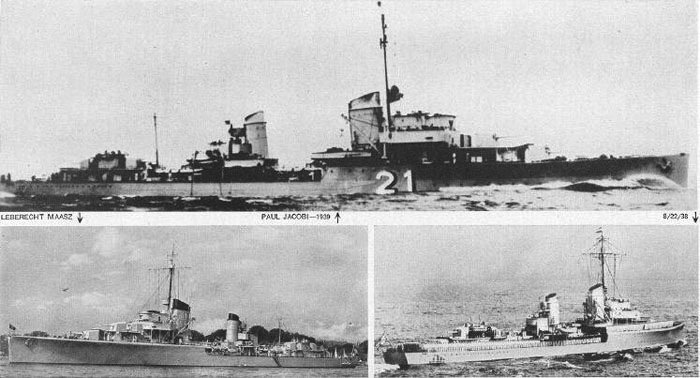
The 1934 Type destroyers (Zerstörer) were the first Kriegsmarine true fleet destroyers, illegal as per the Versailles Treaty when developed from 1932, and legalized (but by declaring fake tonnage) after the Anglo-German naval agreement of 1935…
For this important new line tree, we are going to make an overview of all six active types of destroyers of the Kriegsmarine in WW2, from the 1934 to the 1936B type. The first, 1934 type was started in 1933 out of the blue, as there was no experience since 1918. These really solidified the aspects, equipments, layout, performances of the 22 destroyers built as war broke out in ww2, up to the 1936B type and influenced still the next five projected classes. Erich Raeder’s Plan Z indeed planned a total of 68 destroyers. The grand total ever completed was 30 so less than half.
The four destroyers formed a squadron, training from commissioning in 1936-37 until 1939, taking part in the occupation of Memel, Lithuania by early 1939. Z1 Leberecht Maass her her sisters trie to prevent Polish ships top escape during the invasion. They layed minefields in the German Bight, patrolled the Skagerrak, took part in peration Wikinger, took part in the attack on Narvik. Z4 Richard Beitzen was the only one to survive the campaign, a battle in the English Channel in 1941, the Barents Sea in late 1942… #kriegsmarine #germannavy #germandestroyer #1934destroyer #maass #weserubung #narvik
Introduction
In total, Nazi Germany had only 22 destroyers when the war broke out in September 1939. This was one of the smallest destroyer force in any major navy at the time, below Italy of France and above Sweden or Spain. But like for the Bismarck class battleships, it was decided to create really capable, powerful destroyers on least on par or superior to their competitors, provided other missions would be filled by cheaper torpedo boats. They absolutely dwarved the models built in WWI, and started with last of their best and largest design, the S113 class of 1918. Based on a 1,625 tonnes standard tonnage, it was already above the norm.
Changing Treaties restrictions
The Naval Treaty of 1930 restricted cruisers further and limited destroyers by fear of nations circumventing the limitations by built intermediate “scouts” or flotilla leaders around 3000 tonnes and heavily armed. The maximum tonnage for destroyers was the restricted to 1,500 ton standard, with yet a compromise reach for a small fraction of the destroyer fleet allowed to be slightly heavier at 1,850 ton (understood as flotilla leaders). Germany however, until the Anglo-German naval agreements of 1935, was out of these terms, and under Versaille’s, defined the Reichsmarine could have a maximum number of 12 destroyers retained from prewar or wartime stocks not attributed as war prizes in 1919, BU or scuttled.
And they will be restricted to a 800-long-ton (810 t) limit. In 1933, it was understood that these pre-WWI destroyer had reached their useful life, and still under Versaille’s and allied commission approval, could be replaced. The Reichsmarine however in 1932 when design work started seemed to be little concerned by the 800-ton limit. It was understood not to be followed even before Hitler came to power in 1933. The anglo-german naval agreement from downing street perspective, was hopefully be able to procure a limitation frame to German destroyer construction, but at that stage initial specs were already written.
Starting from scratch
If these were certainly early designs floating around for destroyers in the Reichsmarine’s years, the replacement of the older destroyers was the only justification to launch more thorough studies, and this was achieved by 1932. The Kriegsmarine’s naval staff looked at other navies own develoment since the last 15 years, post-WWI. Primary specifications were easy to reach: A top speed of no less than 36 knots, a forecastle, five single main guns, two torpedo tubes banks with standard 53 cm types (quadruple given the latest trend) and a substantial defensive FLAK, plus minelaying capabilities. One of the foreign tendencies was defined in 1916 already when Britain started working on 1,600 tonnes flotilla leaders.
It was understood that the Scott class became the base to design Britain’s first new destroyers in a decade, the A class of 1928. The smaller, twin mounts designs of the Italians were also looked at but seemed tailored best for the Mediterranean, not the north sea and Atlantic. The Soviet designs seems equally small and limited to Baltic operations.
The French designs were also stuck between extremes of “super destroyers” and smaller ones, while the US was seemingly following the same path, replacing its WW1 fleet. The Japanese just unveiled the “special types”, starting with the Fubuki class showing an upscaling with more torpedo tubes banks and twin mounted guns, but it’s not certain it influenced the German naval staff as much.
Development
Design work on started under the Reischsmarine in 1932, with initial designs going for a large ship, far more powerful than French and Polish destroyers in service. This design grew even as it was to received roles of a small cruiser, including commerce raiding, which above average implied speed and range, as well as greater seakeeping qualities. It was easy to brush aside the old 800 tonne limit since France and Britain were not disarming and the specifications finalized in 1934 with four ships ordered in July. It was one year before the agreement with Britain which opened the 1500 tonne limit to Germany, so we can wonder if the design was ever seen by the allied commission, or considered.
The design work presented hower some initial faults, and like the Schanrhorst class, the short forecastle, straight bow and limited bow flare compromised seakeeping from the start. Armament was heavy and stability quite poor, with high final metacentric height typical of trying to match a 1500t standard. The most innovative part of the design were the ship’s high-pressure boilers. They were a brillant, modern but very complicated design, untested, when installed. Like for the first German interwar Torpedo Boats these powerplants were soon seen as unreliable. They frequently broke down and plagued these destroyer’s operational capabilities, although the stop speed given were stellar. These were completed just as the Anglo-German Naval Agreement made their displacement “legal”.
In the end, and given its defined missions, they could have been around the limited displacement set up, but under the influence of Hitler, wishing to have better ships type for type, and despite some reserves from Raeder, it was established a larger tonnage overall. It was setup right up to the “flotilla leader” tonnage although it was understood this scale would be only applied to standard destroyers. In fact, a “destroyer leader” type was later planned, the famous 1940, 6,000 tonnes Type Spähkreuzer (scouts). Germany would only have standard destroyers.
The end results of these discussions was to choose in the end a large destroyer design, with room for future upscaling in armament, great speed and good firing systems, even radars still in their infancy at the time, many other new systems would be implemented for a truly avant-guard design.
High Standards Construction
 The final Type 1934 approved that year by Hitler were technically much more complex and therefore more complicated in construction than British ships from the same period, with a displacement up to 3,250 tons fully loaded, well beyond treaty limits. To circumvent enquiries by the allied commission it was just decided to lie about the standard displacement. Officially they were laid down as 1,500 tonnes destoyers… But construciton wise it had an immediate problem, compounded by the lack of experience for these ships in German yards. The most capable, Deutsche Worke in Kiel were chosen for a first “test” class of four Zerstörer, limited under high standard of shipbuilding required, with a high costs (total 54,749,000 marks), long construction time for their type. In addition, some technological choices proved too optimistic as some of these were not yet fully developed. This path was continued with their successors, the 1934A type, this time a fully fledged two squadrons (8 ships). The 1934 tyope overall, 12 ships strong, was tasked to replace the very old ships still retained by the Reichsmarine as “destroyers”. But the end result of this quest for individually better ships meant at the end Germany had very few destroyers when the war broke out, and could never later compensate for the heavy losses taken in Operation Weser in April 1940.
The final Type 1934 approved that year by Hitler were technically much more complex and therefore more complicated in construction than British ships from the same period, with a displacement up to 3,250 tons fully loaded, well beyond treaty limits. To circumvent enquiries by the allied commission it was just decided to lie about the standard displacement. Officially they were laid down as 1,500 tonnes destoyers… But construciton wise it had an immediate problem, compounded by the lack of experience for these ships in German yards. The most capable, Deutsche Worke in Kiel were chosen for a first “test” class of four Zerstörer, limited under high standard of shipbuilding required, with a high costs (total 54,749,000 marks), long construction time for their type. In addition, some technological choices proved too optimistic as some of these were not yet fully developed. This path was continued with their successors, the 1934A type, this time a fully fledged two squadrons (8 ships). The 1934 tyope overall, 12 ships strong, was tasked to replace the very old ships still retained by the Reichsmarine as “destroyers”. But the end result of this quest for individually better ships meant at the end Germany had very few destroyers when the war broke out, and could never later compensate for the heavy losses taken in Operation Weser in April 1940.
-Z1 (Maas) was the first destroyer built in Germany since World War I, ordered on 7 July 1934, laid down on 10 October 1934 (number K232), launched on 18 August 1935, completed on 14 January 1937.
-Z2 (Thiele) was ordered on 7 July 1934, laid down on 25 October 1934 (number K243) and launched on 18 August 1935, completed on 27 February 1937.
-Z3 (Schulz) was ordered on 7 July 1934, laid down on 2 January 1935 (number K244), launched 30 November 1935, completed on 8 April 1937.
-Z4 (Beitzen) was ordered on 7 July 1934, laid down on 7 January 1935 (number K245), launched on 30 November, completed on 13 May 1937.
Peculiar naming conventions
The Type 1934 destroyers, dated from their approval and construciton order, were also known as the “Z1” class. It would start a naming tradition. “Z” was standing for “Zerstörer” as much as “T” stand for “Torpedoboote”, “U” “Underzee TB”. A straithforward classification procedure. But it was also decided to name them from German officers Killed in World War I unlike many other navies that choose non-personal names, but adjectives, weapons, allegories, etc. Germany would share this naming tradition only with the US. Hence the “Leberecht Maass” class after the lead ship, would only be four destroyers, approved by the parliament as replacement (ersatz) to replace four former Reichsmarine ships. They were built under the Kriegsmarine in 1935.
Design of the class
Hull and general design
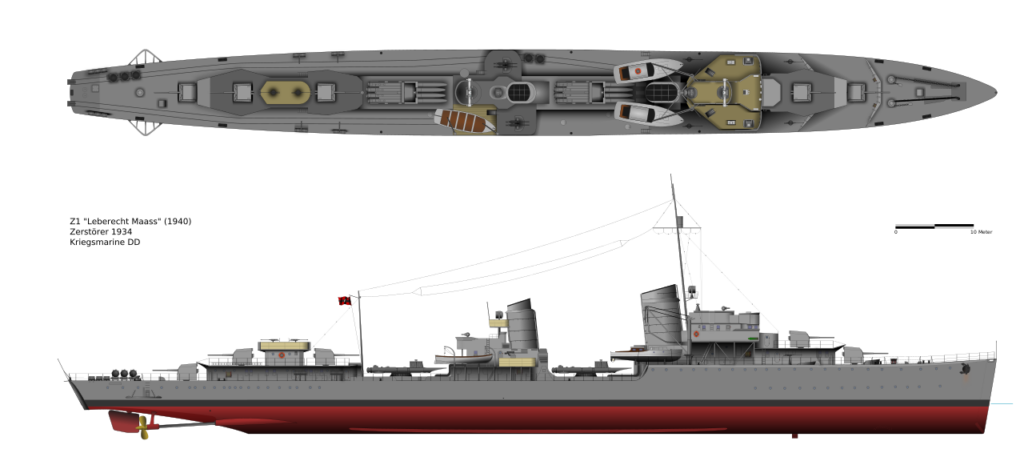
Rendition of Z1 as completed in 1937
The Type 1934 destroyers were large destroyers indeed, even with a straight bow, they reached 114 metres (374 ft) long between perpendiculars and 116.25 m (381 ft 5 in) at waterline, 119 m (390 ft 5 in) overall. After modifications with a clipper bow this went even further. The 1934A reached 121m, 123 for the 1936, 127 for the 1936A, A mod and B, even 132 on the unbuilt 1944 type. They were only comparable to the British “Tribals” in some way, or Japanese destroyers. The beam of 11.31 m (37 ft 1 in) gave them an almost 1/11 ratio, idea for speed but not for stability.
They had a draught of 3.82 m (12 ft 6 in) up to 4.23 m (13 ft 11 in) when fully loaded.
Setup at 1625 tonnes standard, just 25 above the treaty limit as measured after completion, their overall fully loade displacement grew even larger, from 2,578 long tons (2,619 t) as designed, to 2,223 long tons (2,259 t) standard load and 3,156 long tons (3,207 t) full load, way, way above what was stated. In 1936 they were clearly off the charts. Metacentric height was initially 0.79 m (2 ft 7 in) fully load, 0.6 m (2 ft) half loaded and they rolled a lot despite counter keels and active stabilizers. For ASW protection they had a subdivision into 15 watertight compartments separated by bulkheads. The amidship section 7 contained the main propulsion and auxiliary machinery. Only there was a double bottom section over 48% of the lenght.
The hull had fine entries, but a relatively narrow bow/forecastle section with little flare, which proved problematic as they ploughed heavily in heavy weather. The equal beam section was short, about 1/3 of her lenght with a rear deck section starting to thin up to the stern quite early aft of the second torpedo tubes banks. The transome stern was remi-rounded with a lot of flare to clear up falling mines. There were two shaft lines with struts, and a rounded, long but not tall single rudder.
As for their general outlook they looked racy, balanced, with two unequal size raked funnels, main aft of the bridge, and a smaller one aft. She had two masts, one marhe tripod mainmast and a half-mast pole aft to support wireless cables. The bridge’s shape was setup and did not changed for the next six classes. See from forward it was cross-shaped. It was not squared however comprising a near-flat but still roudned face, enclosed bridge with five windows and broad wings, extending aft in a narrowing section. Unlike future destroyers, and like the 1936A, their rooftop open bridge was rounded and small, most if its space was taken by the main forward telemeter. The main mast had a tall spotting top, inheritance of the 1932 design, but after completion in 1936, work started on early radars (see later). In 1939-40 the forward section saw the addition of a bulwarked open bridge.
The hull was divided by sections between a raised platform supporting the two torpedo tubes banks to avoid them being awashed by seawater in rough weather. They created two islands, the middle one around the aft funnel supporting the main FLAK mounts and supporting a platform with searchlight. The second one was forward, at the foot of the tripod mainmast. There was a long structure aft to support the two upper aft main guns, plus a top structure supporting more FLAK (see details later). They had mine rails installed all along the aft deck section, but only the left section ran all the way from the forecastle. The starboard rails were shorter.
The Z1 class had a complement of 10 officers and 315 enlisted men, and wehn used as flotilla flagships, and additional 4 officers and 19 enlisted men. They carried two motor pinnaces on davits either side of the main funnel, and a torpedo cutter suspended under davits on the starboard side of the aft funnel island. The two pinnaces were served by two pole cranes aft of the brigde’s wings.
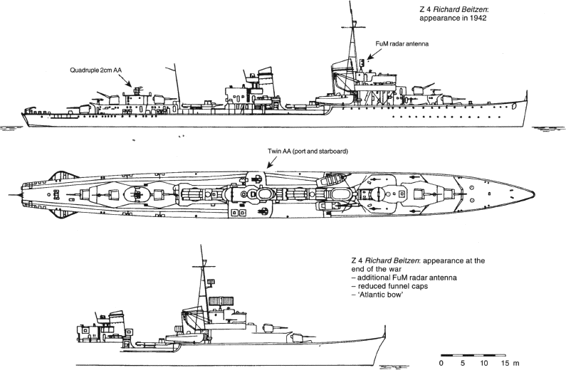

Modifications
Powerplant
The Type 1934 class had two Wagner (Deschimag) geared steam turbine sets. They drove a bronze three-bladed, 3.25-meter (10 ft 8 in) propeller each. Superheated steam came from six Wagner water-tube boilers which operated at 70 atm (1,029 psi; 7,093 kPa) and a temperature of 450 °C (842 °F). This gave these destroyers a total of 70,000 shaft horsepower (52,000 kW). To compare, the Tribals were limited to 44,000 shp (33,000 kW). This was equal to the french “super destroyers” of the Le Fantasque-class (74,000 PS/54,000 kW; 73,000 shp) capable of 40+ knots.
This massive powerplant was intended to provide them a contracted speed of 36 knots (67 km/h; 41 mph). In reality on trials they reached 38.7 knots (71.7 km/h; 44.5 mph), making them among the fastest destroyers ever built. However this speed was at light load on lake-like waters. In heavy weather the practucal speed fell to c30 knots. For autonomy they carried 752 metric tons (740 long tons) of fuel oil, procuring them a conmfortable range of 4,400 nautical miles (8,100 km; 5,100 mi) at 19 knots (35 km/h; 22 mph).
But in reality, early service in 1936-37 showed they were top-heavy, so much that to keep them stable, 30% of the fuel was not burned, but retained as ballast. Effective range was not as impressive as on paper and ended of 1,530 nmi (2,830 km; 1,760 mi) at 19 knots, combat-loaded. In addition to their main machinery, they had two steam-driven 200-kilowatt (270 hp) turbogenerators located in their respective engine room to power everything on board. The backup, machines cold at anchor, were three diesel generators: Two of 60 kW (80 hp), one of 30 kW (40 hp) for 200 hp total, placed in a single separated compartment between the two rear boiler rooms.
Armament
On paper, their main armament was less impressive than other characteristics. Five main guns, eight AA guns, two quad torpedo tubes. They had mines but lacked any ASW weapon at first, but it was changed. They originally only had four main guns, but during the design phase in 1932-33, under personal order of admiral Erich Raeder, a fifth gun was added, whereas the triple TTs were replaced by quadruple ones.
12,7-cm-Schnelladekanone C/34
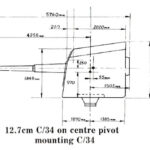 The Z1 class had five 12.7 cm (5 in) guns (a rather standard caliber for the time). These were all shielded, in single mounts: Two superimposed forward, three aft incuding two facing aft, one superfiring, and one facing frorward, the intermediate N°3 mount. For these, they carried 600 rounds of ammunition.
The Z1 class had five 12.7 cm (5 in) guns (a rather standard caliber for the time). These were all shielded, in single mounts: Two superimposed forward, three aft incuding two facing aft, one superfiring, and one facing frorward, the intermediate N°3 mount. For these, they carried 600 rounds of ammunition.
⚙ specifications SK 128 mm (5.04 in) C/34 |
|
| Weight | 3,645 kilograms (8,036 lb) |
| Lenght | 5.76 meters (18 ft 11 in) oa, barrel 5.43 meters (17 ft 10 in) bore |
| Elevation/Traverse | −10° +30°, variable, c300° |
| Loading system | Vertical sliding-block |
| Muzzle velocity | 830 meters per second (2,700 ft/s) |
| Range | 17.4 kilometres (19,000 yd) at 30° |
| Guidance | Optical, data from FCS |
| Crew | c8 |
| Round | 128 x 680mm R separate-loading, cased charge 28 kilograms (61.7 lb) |
| Rate of Fire | 15–18 rpm (maximum) |
FLAK
The anti-aircraft armament (FLAK) comprised the following:
-Four 3.7 cm (1.5 in) anti-aircraft guns, all in single mounts (8,000 rounds of ammunition)
-Six 2 cm (0.79 in) anti-aircraft guns, single mounts (12,000 rounds of ammunition).
Upgrades were made on surviving Z4:
She received improved 2 cm C/38 guns instead of the C/30 guns in 1941, plus three more. The two placed on the aft shelter deck were replaced by a single 2 cm Flakvierling mount, probably late 1941 refit.
Torpedoes
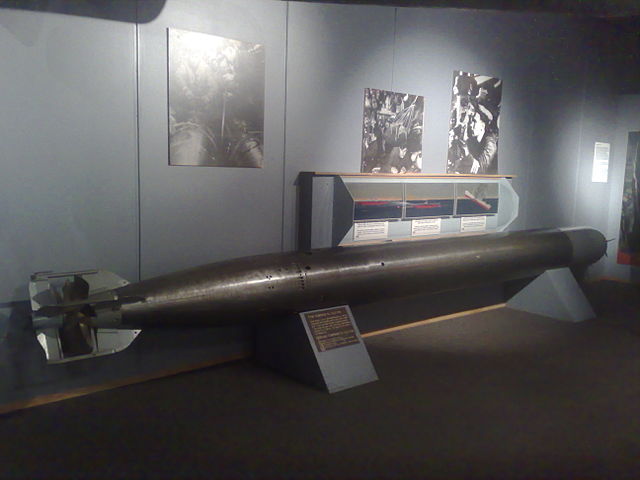
They had eight 53.3 cm (21 in) torpedo tubes, in two quadruple, centerlined in electrically power-operated mounts. They had reloads, obut only four torpedoes, two for each bank.
They were of the 1934 53.3 cm (21″) G7a T1 “ato” class. read more
⚙ specifications TORPEDO |
|
| Weight | 3,369 lbs. (1,528 kg), Negative Buoyancy 605 lbs. (274 kg) |
| Dimensions | 23 ft. 7 in. (7.186 m) |
| Propulsion | Decahydronaphthalene (Decalin) Wet-Heater |
| Range/speed setting | 6,000 m/44 knots, 8,000 m/40 knots, 14,000 m/30 knots |
| Warhead | 617 lbs. (280 kg) Hexanite |
| Guidance | Federapparattorpedo; 1944 Lagenunabhängiger Torpedo |
Mines
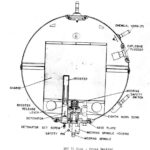 These were EMC Contact Mines, placed on trolley rails. Maximum capacity was 60 mines. These were spherical mines 44 inch (1.12 m) in diameter. Charge of 661 lbs. (300 kg). Used 7 Hertz horns. Could be moored in 55, 109, 164 or 273 fathoms (100, 200, 300 or 500 m). First captured by the British in October 1939. more on navweaps
These were EMC Contact Mines, placed on trolley rails. Maximum capacity was 60 mines. These were spherical mines 44 inch (1.12 m) in diameter. Charge of 661 lbs. (300 kg). Used 7 Hertz horns. Could be moored in 55, 109, 164 or 273 fathoms (100, 200, 300 or 500 m). First captured by the British in October 1939. more on navweaps
ASW
These were four Wasserbombenwerfer C/35 depth charge projector, each aft on the broadsides, close to the freeboard to clear the mine rails. Fired a Rheinmetall 606 lbs. (275 kg), initial velocity of 115 fps (35 mps) and an arbor weight of 77 lbs. (35 kg). “They had four depth charge launchers mounted on the sides of their rear deckhouse, which was supplemented by six racks for individual depth charges on the sides of the stern, with either 32 or 64 charges carried.”
Fire Direction and sensors
The Type 34s were equipped with a C/34Z analog fire-control director installed on the bridge’s roof. It was tasked to calculate gunnery data, using range estimates thanks to a pair of 4-meter (13 ft) stereoscopic rangefinders: One was behind the director on the bridge’s roof and the other abaft the rear funnel. Data transmitted were the bearing and elevation respective to their positions to all gun crews. They were abe to fire simultaneously on target.
-There was a secondary FLAK rangefinder which was a smaller 1.25-meter (4 ft 1 in) model to the 3.7 cm AA guns.
-There was a tertiary hand-held 0.7-meter (2 ft 4 in) rangefinder for the 2 cm FLAK guns as well.
-There were passive hydrophones for ASW: The ‘GHG’ (Gruppenhorchgerät) to detect submarines.
-From 1940, Z4 Richard Beitzen was fitted with a S-Gerät sonar.
-In 1942, the same Z4 reveived a FuMO 24 radar.
-In 1944, Z4 saw this radar upgraded to the FuMO 63K Hohentwiel radar and FuMB 6 Palau ECM suite
Modifications
After trials revealed shortcomings in seakeeping and stability, changes were made. First off they were fitted with a staukeil, short keel with a shallow wedge-shaped cross-section added under transoms to improve the turning circles, raise the stern at high speed. This however forced the bow to even dig deeper, spraying over the bridge and making the first main gun on deck inoperable. It also caused a sagging force on the hull. So all four were seriously reinforced amidships with thicker hull plates. The staukeils cause so many issues they were were removed in 1940–1942.
-Their bows were rebuilt in 1938–1939, with more sheer and retractable bow spar making them 114.4 m (375 ft) between perpendiculars, 119.3 m (391 ft) long overall
-Stabilizers were replaced by bilge keels.
-The upper bridge was rebuilt as a squared one to increase space.
-In 1942 the survivor Z4 Richard Beitzen had her funnels lowered. In 1944 her stem rebuilt in a clipper style, she was now 121.3 m overall. She also received AA, sonar and radar upgrades.
The active sonar S-Gerät system was noted to be installed on Richard Beitzen by June 1940, but the exact date is unknown. Her FLAK was augmented, see notes in the AA section.
⚙ specifications |
|
| Displacement | 2,223 long tons (2,259 t) Standard, 3,156 long tons (3,207 t) |
| Dimensions | 119 x 11.31 x 4.23m (390 ft 5 in x 37 ft 1 in x 13 ft 11 in) |
| Propulsion | 2× shafts geared steam turbines, 6× water-tube boilers 70,000 PS (51,000 kW; 69,000 shp) |
| Speed | 36 knots (67 km/h; 41 mph) |
| Range | 1,530 nmi (2,830 km; 1,760 mi) at 19 knots (35 km/h; 22 mph) |
| Armament | 5× 12.7 cm (5 in), 4× 3.7 cm, 6×2 cm FLAK, 2×4 53.3 cm TTs, 4× DCR, 6× racks, 60× mines |
| Crew | 10 officers, 315 enlisted |
 Z1 Leberecht Maas
Z1 Leberecht Maas
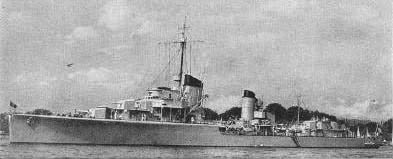
Z1 Leberecht Maass (named after a Rear Admiral killed at the Battle of Heligoland Bight) was completed on 14 January 1937 under command of Korvettenkapitän Friedrich T. Schmidt. She became TB leader or flagship, Führer der Torpedoboote (FdT) on 1 May. She trained in the eastern Baltic until the end of the year and visited Gothenburg in Sweden by early April 1938. She sailed to Kiel to have her bow rebuilt and participated in the summer 1938 Fleet Review and fleet exercise. Gerhard Wagner replaced Schmidt in October and by December, she sailed with her three sisters off Iceland to test her seaworthiness in the North Atlantic winter. The redesign of her bow was indeed important for new destroyer classes in construction. On 23–24 March 1939 they escorted KMS Deutschland carrying Adolf Hitler for the formal occupation of Memel. Korvettenkapitän Fritz Bassenge took command and she took part in her first fleet exercise in the western Mediterranean, with Konteradmiral Günther Lütjens on board as flagship. She visited Ceuta and Ría de Arousa (Spain) and was back home on 13 May 1939.
On 1 September she was sent with her sisters in a mission to blockade the Polish coast with three light cruisers and six other destroyers. Z1 evaded a torpedo attack by the Polish submarine ORP Wilk on 1st September. The cruisers were withdrawn and the destroyers remained patrolling.
The Battle of Hel:
On 3 September she and Z9 Wolfgang Zenker closed on the naval base at Hel, spotted the Polish destroyer Wicher and minelayer Gryf, opening fire 12,700 meters (13,900 yd). It was ineffective while Polish return fire was more accurate. So much so both destroyers had to start manoeuvering under smoke. Still, Z1 was hit by a 6.0 in)shell from a coast defense battery at 06:57. She lost her No. 2 gun (4 KiA, 4 wounded) and both fired in common 77 rounds but failed to sink the Polish vessels. They retired due to the danger of coastal battery fire. On the 4th, Z1 sailed back for repairs to Swinemünde, until 10 September (boiler tubes were also changed). She then helped laying defensive minefields in the North Sea, Lütjens moving to Z21 Wilhelm Heidkamp. Z1 was reassigned to the 2nd Destroyer Flotilla (2. Zerstörer Flotille). She was refitted in Swinemünde from 29 September, became afterwards flagship on 30 November with the 2. Zerstörerflotille from 22 December.
Operation Nordmark
She was mobilized for Operation Nordmark a hunt for Allied merchant shipping in the North Sea up to the Shetland Islands. 2. Zerstörerflotille escorted Scharnhorst and Gneisenau and Admiral Hipper on 18 February, but she was detached with Z5 Paul Jacobi to forray in the Skagerrak.
Operation Wikinger and Fate
In cooperation with the Luftwaffe an operation was mounted against supposed British fishing trawlers off the Dogger Bank believed to cooperate with British submarines. By attacking the fishing fleet it was hoped to spread British defences and captured some useful auxiliary ships. The Luftwaffe provided fighter cover, bomber support on demand, and Z1 plus five other destroyers sailed on 22 February, but misidentified and attacked by a lone Heinkel He 111 from Kampfgeschwader 26, which managed to hit Leberecht Maass with a bomb. That tragioc “blue on bliue” not to be repeated, broke her in half.
She sank rapidly with 280 of her crew and captain, 60 saved, but during this rescue Max Schultz hit a mine and sank in turn. Hitler ordered a court of inquiry and blamed the crew of the He 111. Further cooperations with the Luftwaffe was seriously questioned, but the Kriegsmarine recoignised it failed to notify the destroyers that anti-shipping patrols were ongoing, whereas missed to inform the Luftwaffe about its destroyers deployed, and yet, postwar research showed Z1 was also hit by a mine laid by HMS Ivanhoe and Intrepid.
 Z2 Georg Thiele
Z2 Georg Thiele

Z2 was commissioned on 27 February 1937, assigned to the 1st Destroyer Division from 1 December 1937 and visited Ulvik in Norway by in April 1938 with her sisters Z3 Max Schultz and Z4 Richard Beitzen. She had however like Z1 and the others to return to Deutsche Werke to have her bow rebuilt. She was present for the 22 August Fleet Review attended by the Fuhrer and Miklós Horthy. By December she sailed with her sister to test her metal in Iceland.
On 23–24 March 1939 she escorted Deutschland to Memel, followed by the spring exercise, western Mediterranean, Spanish and Moroccan visited in April-May and in September she was deployed in the Baltic for the blockade but soon transferred back to the German Bight to lay a defensive minefields. She was refitted afterwards until April 1940, just on time for the Norwegian Campaign.
Battles of Narvik
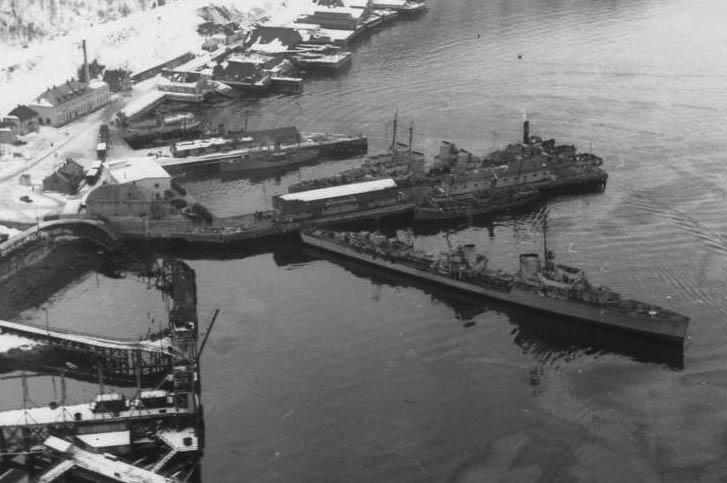
Z2 Georg Thiele was assigned to Group 1, Operation Weserübung, April 1940. She protected and partly transported the 139. Gebirgsjäger Regiment, being also the headquarters for the 3. Gebirgs-Division, objective Narvik. She hosted these on 6 April and departed with her group the 7th, arriving at the Ofotfjord on 9 April. Commodore Friedrich Bonte aboard his flagship Wilhelm Heidkamp ordered Z4 and Z11 to scout the fjord to Narvik, helped by a heavy snowstorm until they reached the pier. Mountain troops scrambled to action, until they were spotted by the old coast defense ship Norge which opened fire, sending thirteen 21 cm (8.3 in) shells from just 600–800 meters (660–870 yd) before beign silenced by torpedoes. Amazingly, visibility was so poor that despite the close quarters, none of the destroyers was hit…
Thiele and von Arnim refuelled from a German tanker which entered Narvik before moving to Ballangenfjord, in the southern arm and close to the entrance. On 10 April five British destroyers of the 2nd DFlotilla (HMS Hardy, Havock, Hunter, Hotspur, Hero of the H class) surprised five German destroyers in harbor, opening fire whith all they had, and starting with a volley of torpedoes. Two destroyers were sunk outright, the rest badly damaged, withdrawing until meeting the three destroyers of the 4th Flotilla from the Herjangsfjord, in the rescue. Gunnery was innacurate due to a British smoke screen, retiring to the Ofotfjord. The Germans also retired to escape a salvo of torpedoes. Thiele and von Arnim, now also alerted came in reinforcement through the smoke to engage the British destroyers.
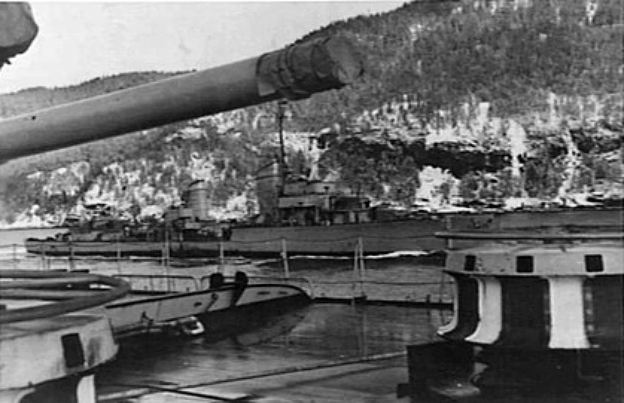
Z2 escorting Hipper
They basically crossed their T, firing full broadsides from 4,000 meters (13,000 ft) and hitting hard the flag HMS Hardy (bridge destroyed, two fwd guns off), she had to beach herself. Then Z1 and her companion assaulted HMS Havock but were ineffective, as well as with torpedoes. Havock managed to escape. HMS Hunter was next to be hit, put on fire, believed hit by a torpedo, rammed from behind by HMS Hotspur manoeuvering as she lost steering control. Hotspur disengaged again, Hunter sank later. The three other British DDs escapeed under a smoke screen. Georg Thiele received 7 hits, forward gun, fire-control, one magazine flooded, fires, 13 KiA, and by the night of 12/13 April she was under command by Erich Bey (later on Bismarck), surviving senior officer. He expected a british return in force while scrambling repairs under repairs. Her had four guns working and six torpedoes left. Ultimately she was not ready to depart on 13 April when HMS Warspite arrived escorted by nine destroyers, catching the German DDs. They tried, with Z2 Thiele, charged out of Narvik harbor and engage them, but this was an unequal fight.

They soon had to retreat to Rombaksfjorden, eastern branch of the Ofotfjord for mounting an ambush of pursuing British destroyers. Z2 was posted at the Straumen narrows with Z18 Hans Lüdemann while the others scuttled themselves. Lüdemann was spotted engaged first, retreating further until exhausting all ammunition.
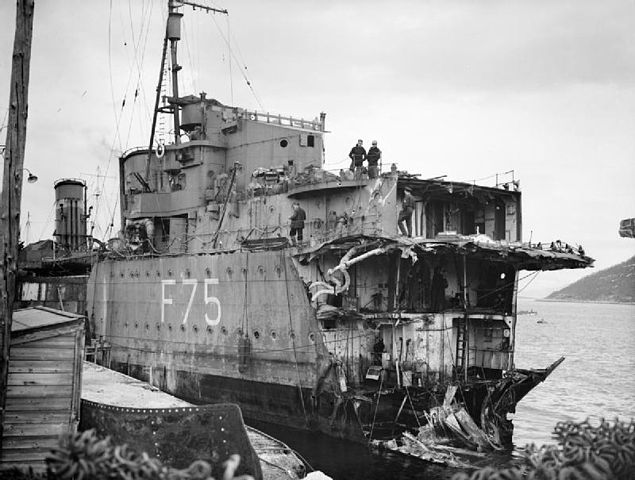
She shattered bow of HMS Eskimo, hit by Z2 Georg Thiele. Only the Tribals were worthy opponents of German destroyers at the time.
Thiele was next, but she sent torpedoes which blew the bow off HMS Eskimo (of the mighty Tribal class) while being soon under heavy gunnery fire. Korvettenkapitän Max-Eckart Wolff tried to beach the ship for the crew to escape, ordering abandon ship afterwards, and 14 only died during the battle, 28 wounded. The rest of the crew joined the mountain troops and continued the fight in Narvik, in the Marine-Regiment Berger. For his bravery, the captain was awarded an Iron Cross First Class on 12 May 1940, Knight’s Cross of the Iron Cross in August. Today, the wreck of Z2 is a popular diving site, and it was in the documentary series Abandoned Engineering.
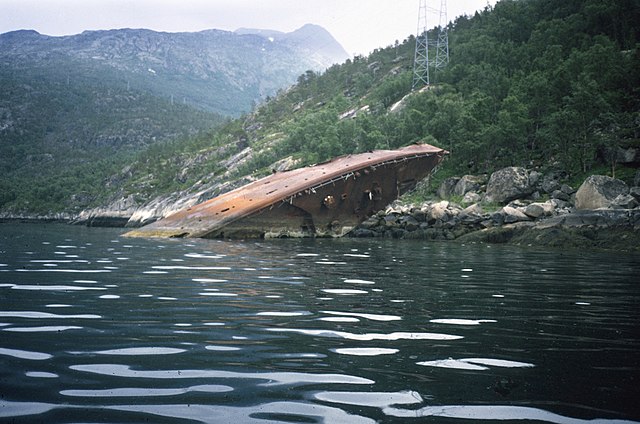
The wreck of Z2 today
 Z3 Max Schulz
Z3 Max Schulz

Schulz was commissioned on 8 April 1937 (Named after V69 captain, killed in action in January 1917) under Korvettenkapitän Martin Balzer. She was assigned to the 1st Destroyer Division from 26 October 1937, visited Ulvik wuth Z2, Z4, had her bow rebuilt, took part in the August Fleet Review, fleet exercise, sailed to Iceland in winter, escorted Adolf Hitler to Memel, was at the spring fleet exercise in the western Mediterranean (as flagship, Rear Admiral Günther Lütjens).
On 27 August 1939 she accidentally collided with (rammed) the torpedo boat (former destroyer) KMS Tiger, near Bornholm in early morning mist. The latter sank, two killed instantly, six wounded. Z3 had her bow severely mushed and was towed stern-first by Z2 until taken by tugboats to Swinemünde at 4 knots, repaired and missing the Polish Campaign.
She was sent to the Skagerrak inspecting neutral shipping in October, but on 28 October, une steam turbine exploded, boiler room No. 1 was flooded and she lost all power. She could not be towed by manage to do repairs and regain power to sail back to Kiel. With Beitzen and Z16 Friedrich Eckoldt she later laid 110 magnetic mines off Harwich in the night of 9/10 February 1940, claiming six steamers for 28,496 GRT, damaged another.
On 22 February, Z3 and her sisters Z1, Z4 plus Z6, Z13, Z16 headed for the Dogger Bank as part of “Operation Wikinger” but were attacked en route by an unaware patrolling Heinkel He 111, destroying her sister Z1 Leberecht Maass. While trying to rescue her crew she herself hit a British mine previously laid by Ivanhoe and Intrepid. She sank with all hands.
 Z4 Richard Beitzen
Z4 Richard Beitzen
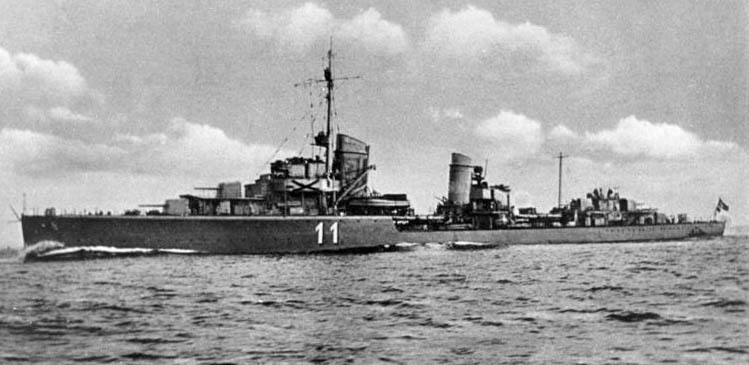
Z4 was named after an Imperial German Navy officer at the head of the 14th Torpedo Boat Flotilla, killed in action in March 1918. After commission on 13 May 1937 like her sister she visited Ulvik, Norway, had her bow rebuilt, took part in the same August Fleet Review and exercise, joined the 1st Destroyer Flotilla, sailed to Iceland, escorted Adolf Hitler to Memel, was at the western Mediterranean exercise but upon her return she accidentally rammed the stern of escort ship F9.
Like her sisters she was deployed for the September 1939 Polish blockade in the western Baltic, but soon countermanded and ordered to Kattegat to inspect neutral shipping, suffering from turbine issues. The night of 12/13 December saw her laying a minefield off the British coast, under ordered from CADM Friedrich Bonte (flagship Z19 Hermann Künne) she sailed with Z8 Bruno Heinemann, Z14 Friedrich Ihn and Z15 Erich Steinbrinck. In all, 240 mines were placed off the mouth of the River Tyne, which later claimed some 18,979 GRT. Back home they were asked to escort back the damaged KMS Leipzig and Nürnberg, both torpedoed by HMS Salmon as they were placed in distant cover for the operation. HMS Ursula sneak inside the screen and fired six torpedoes at Leipzig in the Elbe on the 14th, but two hit F9 instead, sinking rapidly with all hands.
There was another destroyer minelaying sortie, this time to the Newcastle area (10/11 January) with Z21, Z16, Z22, Z20. F. Ihn had boilers issues and was eventually escorted back by Z4, so she missed the mision. Their minefield only claimed a fishing trawler. Z3, Z4, Z16 would later lay 110 magnetic mines off Harwich on 9/10 February 1940, more successful.
Z4 also participated in Operation Wikinger on 22 February 1940, with her sisters Z3, Z1, Z6, Z13, Z16 sailing to the Dogger Bank when attacked by a Heinkel He 111 seeing both Z1 Leberecht Maass and Z3 Max Schultz disappear in one go. The mission was cancelled.
She would howevere took part in the German invasion of Norway
Operation Weserübung
Z4 was prepared for the operation on 9 April, sailing on the 11th with KMS Köln to Wilhelmshaven. She helped laying a minefield in the Kattegat (28 April to 20 May), followed by a refit and was transferred to Brest (Britanny, France) in October. On the night of 24/25 November with Z10 Hans Lody and Z20 Karl Galster she sallied forth to the Finisterre, spotting and engaging British fishing ships SW of Wolf Rock. Next, theu spotted a small convoy, one of three merchantmen was sunk, another damaged, but the British 5th Destroyer Flotilla was alerted and sallied forth. The German destroyers were however too fast to intercept before dawn. Three nights later, same mission, two tugboats and a barge sank (424 GRT) and they were intercepted in time by the 5th Destroyer Flotilla at 06:30 on 29 November. Each German DD fired four torpedoes, two from Z10 hit and badly damaged HMS Javelin but she was towed home. Without much success, the destroyers changed missions.
In January 1941, she helped laying a minefield off the SE English coast and in February escorted Admiral Hipper coming to Brest. Z4 sailed for Kiel on 16 March for a refit and was ordered to Kirkenes, Norway in July 1941, joining the 6. Zerstörer-Flottille. Her first sortie was on 12–13 July. She sank two small Soviet ships, but the destroyers shows poor accuracy, spending 80% off their ammunition. Next sortie was on 22 July, she surprised and sank an immobile Soviet flying boat. During another sortie on the 27th, she ws straddled by shore artillery but sank a converted fishing trawler. She headed for Germany for repairs.
When done, she escorted the battleship Tirpitz in mid-January 1942 from the Baltic to Trondheim. Next she took part with the 5th Zerstörer Flotille from Kiel to Brest on 24 January, escorting the two Schanhorst sisters for their famous “Channel Dash”. On 25 January however Z8 Bruno Heinemann hit two mines (from HMS Plover) off the Belgian coast, sank. Z4 rescued 200 survivors, landed at Le Havre, and reached Brest on the 26th. She departed on 11 February and underway helped to repel a British destroyers squadron attack. She was damaged by a near-miss from a Bristol Blenheim bomber, and shot it down with her Flakvierling. Next back home, she escorted Prinz Eugen and Admiral Scheer to Trondheim, but folded before reaching it due to heavy weather. Prinz Eugen as a result without protection was ambushed and badly damaged by a British submarine. After a machinery overhauled and refit at Bremen on 14 March, Z4 screened Lützow (Deutschland class cruiser, ex-“Deutschland”) to Bogen Bay. She also laid a minefield in the Skaggerak.

Z5 Paul Jacobi
Z4 took part in Operation Rösselsprung, an attempted interception of the Arctic convoy PQ 17 in July 1942, escorting Scheer and Lützow but underway to Altafjord, Lützow and three destroyers ran aground so the operation was aborted. Z4 escorted two oil tankers to the Altafjord on 2–3 July for Operation Wunderland in August with Z16, Z15 and Admiral Scheer heading for the Kara Sea. She escorted the minelayer Ulm to Cape Zhelaniya also this month. On 13–15 October, with Z16, Z27, Z30 she laid a minefield off the Kanin Peninsula, White Sea, claiming the Soviet icebreaker Mikoyan. She later escorted Admiral Hipper for a Murmansk attack of isolated cargoes by early November.
She took part in Operation Regenbogen, an interception of Convoy JW 51B by late December, with Z16, Z29 and Admiral Hipper, making a diversion of convoy escorts to let Lützow and three other destroyers pass unmolested and prey on the convoy. The three destroyers were detached and found the convoy on the morning of 31 December. HMS Obdurate spotted them and a gunnery duel started at 8,000 meters (8,700 yd). Obdurate joined back the convoy under smoke, undamaged. Meanwhile Z4 and the two others were ordered to rejoin Hipper. En route their spotted the minesweeper HMS Bramble, and were ordered to sink her, while Hipper attacked the convoy escorts. Poor visibility saw Hipper surprised by HMS Sheffield and HMS Jamaica. The German destroyers closed on Hipper and confused Sheffield for her. At 4,000 meters (4,400 yd) range they saw the cruiser firing at once with even, the DP guns and AA on Z16. The effect was devastated and she sank with all hands. Z4 escaped into darkness.
Fregattenkapitän Hans Dominik took command of Z4 in January 1943. She escorted the damaged Admiral Hipper and Köln to Kristiansand. She started escorts bertween there and Aarhus in Denmark, and the battleship Scharnhorst to Altafjord by early March, Nürnberg in the Baltic, was refitted at Swinemünde until October 1943. While in the Arctic, she ran aground at the Karmsund, on 27 October, was refloated on 5 November, towed to Haugesund for emergency repairs, then Bergen on 26 November for temporary repairs until 18 December, and Stettin but she had to wait until 17 January for the dry dock to be freed, repairs and modernization were completed in June, followed by machinery issues delaying her until 5 August 1944. She was based on Horten, Norway.
She laid mines in the Skagerrak but ran aground in November 1944, repaired completed by 15 February 1945. She was bombed by the RAF while screening a convoy on 24 April and was repaired in Oslo, but this was still ongoing as the war ended in Europe. She was captured by the British on 14 May, at first turned over as war reparation to the Royal Norwegian Navy on 15 July, and later allocated to Britain, towed to Rosyth in February 1946 and used as a target in September until a serious leak three months later saw her beached. Temporary repairs were followed by a sell of January 1947 to C. W. Dorkin for breaking for breaking up at Gateshead, 10 January 1949.
Read More/Src
Books
Gröner, Erich (1990). German Warships 1815–1945. Vol. 1: Major Surface Warships. Annapolis, Maryland: Naval Institute Press. ISBN 0-87021-790-9.
Hervieux, Pierre (1980). “German Destroyer Minelaying Operations Off the English Coast (1940–1941)”. In Roberts, John (ed.). Warship. Vol. IV. Greenwich, England: Conway Maritime Press. ISBN 978-0-87021-979-5.
Koop, Gerhard & Schmolke, Klaus-Peter (2003). German Destroyers of World War II. Annapolis, Maryland: Naval Institute Press. ISBN 978-1-59114-307-9.
Rohwer, Jürgen (2005). Chronology of the War at Sea 1939–1945: The Naval History of World War Two (Third Revised ed.). Annapolis, Maryland: Naval Institute Press. ISBN 1-59114-119-2.
Whitley, M. J. (1991). German Destroyers of World War Two. Annapolis, Maryland: Naval Institute Press. ISBN 978-1-55750-302-2.
Links
navypedia.org
historyofwar.org/
german-navy.de/
erenow.org/ german-destroyers ww2
de.wikipedia.org
en.wikipedia.org/
alchetron.com
old-forum.warthunder.com/ german-destroyers
Videos
Model Kits
Not much. German DD Z1 – Z4, Classic Warships Publishing 1:700, and German destroyer Z1 Leberecht Maass Eaglewall 1:1200







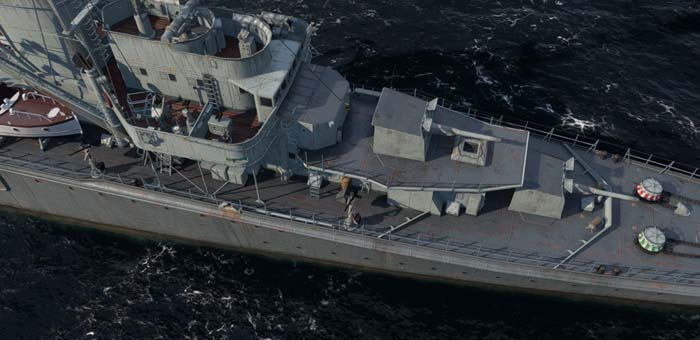

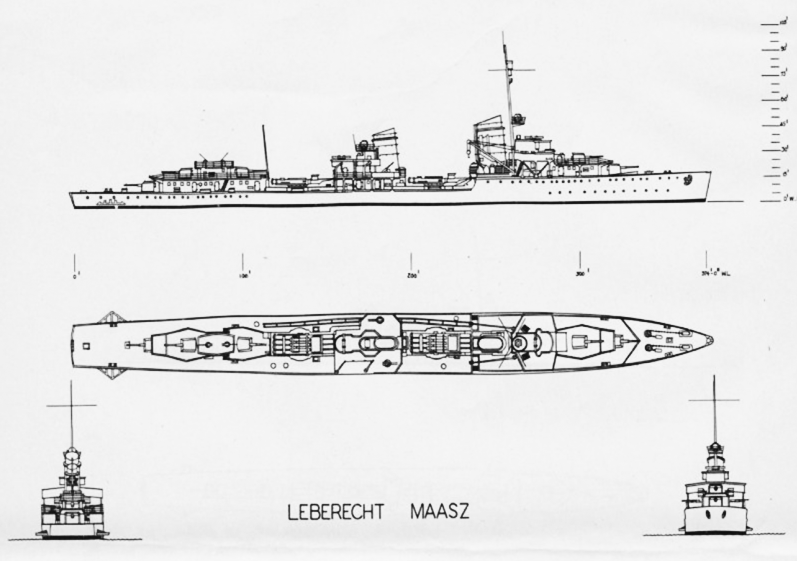
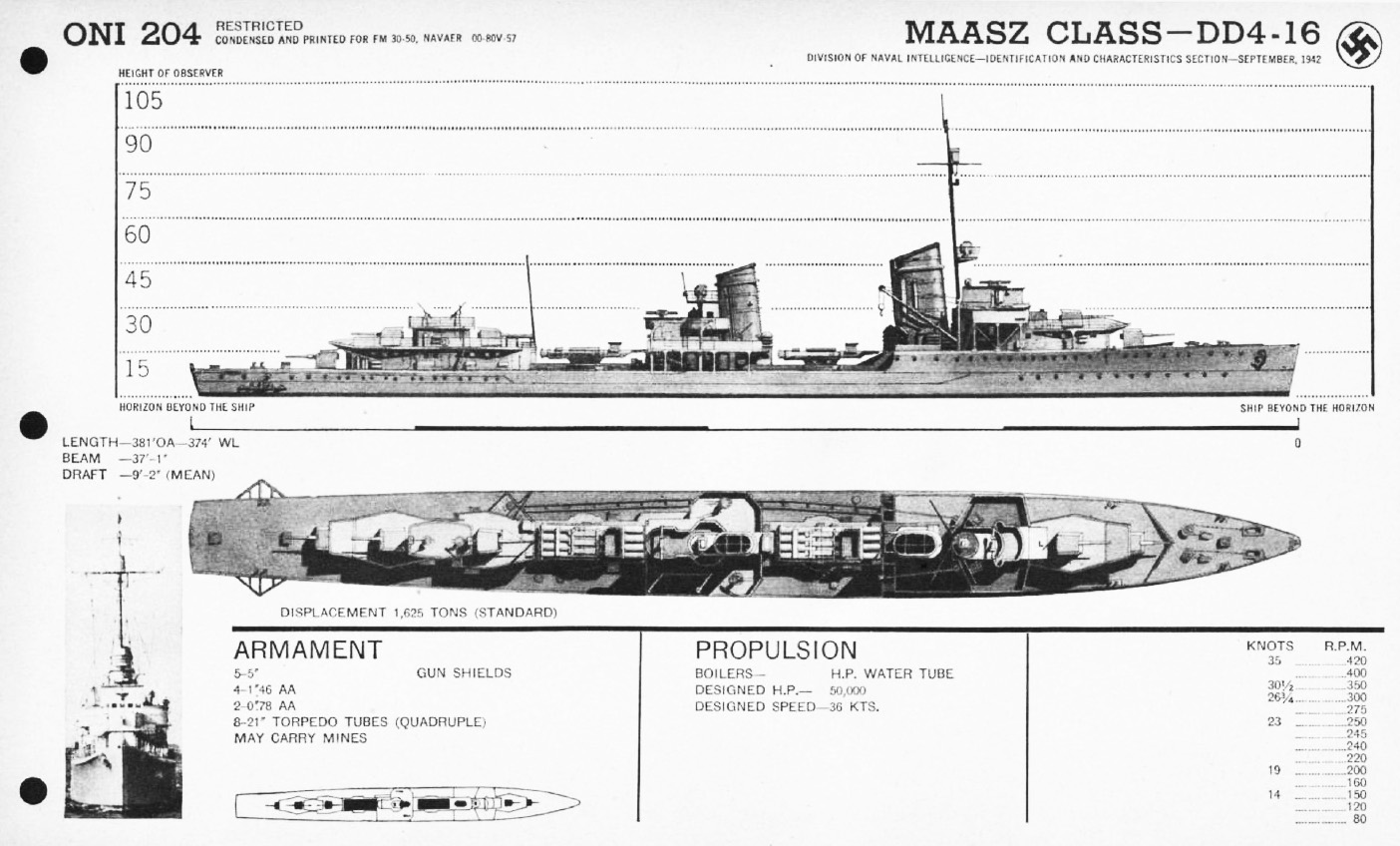

 Latest Facebook Entry -
Latest Facebook Entry -  X(Tweeter) Naval Encyclopedia's deck archive
X(Tweeter) Naval Encyclopedia's deck archive Instagram (@navalencyc)
Instagram (@navalencyc)





 French Navy
French Navy Royal Navy
Royal Navy Russian Navy
Russian Navy Armada Espanola
Armada Espanola Austrian Navy
Austrian Navy K.u.K. Kriegsmarine
K.u.K. Kriegsmarine Dansk Marine
Dansk Marine Nautiko Hellenon
Nautiko Hellenon Koninklije Marine 1870
Koninklije Marine 1870 Marinha do Brasil
Marinha do Brasil Osmanlı Donanması
Osmanlı Donanması Marina Do Peru
Marina Do Peru Marinha do Portugal
Marinha do Portugal Regia Marina 1870
Regia Marina 1870 Nihhon Kaigun 1870
Nihhon Kaigun 1870 Preußische Marine 1870
Preußische Marine 1870 Russkiy Flot 1870
Russkiy Flot 1870 Svenska marinen
Svenska marinen Søværnet
Søværnet Union Navy
Union Navy Confederate Navy
Confederate Navy Armada de Argentina
Armada de Argentina Imperial Chinese Navy
Imperial Chinese Navy Marinha do Portugal
Marinha do Portugal Mexico
Mexico Kaiserliche Marine
Kaiserliche Marine 1898 US Navy
1898 US Navy Sovietskiy Flot
Sovietskiy Flot Royal Canadian Navy
Royal Canadian Navy Royal Australian Navy
Royal Australian Navy RNZN Fleet
RNZN Fleet Chinese Navy 1937
Chinese Navy 1937 Kriegsmarine
Kriegsmarine Chilean Navy
Chilean Navy Danish Navy
Danish Navy Finnish Navy
Finnish Navy Hellenic Navy
Hellenic Navy Polish Navy
Polish Navy Romanian Navy
Romanian Navy Turkish Navy
Turkish Navy Royal Yugoslav Navy
Royal Yugoslav Navy Royal Thai Navy
Royal Thai Navy Minor Navies
Minor Navies Albania
Albania Austria
Austria Belgium
Belgium Columbia
Columbia Costa Rica
Costa Rica Cuba
Cuba Czechoslovakia
Czechoslovakia Dominican Republic
Dominican Republic Haiti
Haiti Hungary
Hungary Honduras
Honduras Estonia
Estonia Iceland
Iceland Eire
Eire Equador
Equador Iran
Iran Iraq
Iraq Latvia
Latvia Liberia
Liberia Lithuania
Lithuania Mandchukuo
Mandchukuo Morocco
Morocco Nicaragua
Nicaragua Persia
Persia San Salvador
San Salvador Sarawak
Sarawak Uruguay
Uruguay Venezuela
Venezuela Zanzibar
Zanzibar Warsaw Pact Navies
Warsaw Pact Navies Bulgaria
Bulgaria Hungary
Hungary

 Bundesmarine
Bundesmarine Dutch Navy
Dutch Navy Hellenic Navy
Hellenic Navy Marina Militare
Marina Militare Yugoslav Navy
Yugoslav Navy Chinese Navy
Chinese Navy Indian Navy
Indian Navy Indonesian Navy
Indonesian Navy JMSDF
JMSDF North Korean Navy
North Korean Navy Pakistani Navy
Pakistani Navy Philippines Navy
Philippines Navy ROKN
ROKN Rep. of Singapore Navy
Rep. of Singapore Navy Taiwanese Navy
Taiwanese Navy IDF Navy
IDF Navy Saudi Navy
Saudi Navy Royal New Zealand Navy
Royal New Zealand Navy Egyptian Navy
Egyptian Navy South African Navy
South African Navy






























 Ukrainian Navy
Ukrainian Navy dbodesign
dbodesign